Intelligent Monitoring System with Privacy Preservation Based on Edge AI
Abstract
:1. Introduction
2. Related Work
| Source | Sensor | Proposed Approach | Outputs | Pros | Cons |
|---|---|---|---|---|---|
| [2] Han-Sol et al. | Camera sensor, PIR sensor, sound sensor | (1) Enhances SURF algorithm: Detects motion between consecutive frames by using the gradients of matched key points. | Detects motion and sound. | It allows precise motion detection. | Unnecessary motions are detected, leading to resource wastage. |
| [28] Vuegen et al. | 27 (Number of microphones) | (1) Mel-frequency cepstral coefficient (MFCC) approach: Feature extraction from acoustic sensor data performed (2) Support vector machine (SVM): ADL classification. | Detects teeth-brushing, dishwashing, dressing, eating, food preparation, table setting, showering, sleeping, toileting, and hand-washing. | Requires only sound sensing technology. Provide rich information | Many sensors are required. Does not preserve privacy. |
| [29] Ghosh et al. | 5 (Number of ultrasonic sensors) | (1) Support vector machine (SVM) with linear kernel, K-nearest neighbor (KNN), and decision tree techniques: Used on ultrasonic sensors data | Detects standing, sitting, and falling. | Utilizes lightweight algorithms. | Ultrasonic sensors are vulnerable to disturbances. |
| [30] Gochoo et al. | PIR, reed switch | (1) The annotated binary data are converted into binary activity images for ADLs. (2) Deep convolutional neural network (DCNN) classifier: Activity images used for training and testing. (3) Classifiers evaluated with the 10-fold cross-validation method. | Detects four ADLs: bed-to-toilet movement, eating, meal preparation, and relaxing. | Performs highly accurate deep learning algorithm computations. | It results in a system that is too heavy for certain environments. |
| [31] Barsocchi et al. | PIR, Reed switch, pressure sensor, electrical power sensors | (1) Magnetic contacts and power usage sensors: Detects status changes. (2) Median filter: Applied to the spikes produced by the power usage sensor of the personal computer. (3) Room-level localization algorithm “where is” (WHIZ): Detects the locations of the elderly. | Detects ADLs such as lunch/dinner, resting/PC/TV, sleeping, and hygiene. | Employs various sensors to sense real-life situations more closely. | It necessitates the use of many sensors. |
3. System Architecture
3.1. Intelligent Monitoring Device
3.2. Edge AI Module
3.2.1. Neuro Controller
3.2.2. Neuro Core
4. System Flow
4.1. Entire System Flow
4.1.1. Flow of Image Preprocessing
4.1.2. MediaPipe
4.2. Edge AI Module Algorithm
5. Experiment
5.1. Software Simulation
5.2. Hardware Implementation
6. Conclusions
Author Contributions
Funding
Data Availability Statement
Conflicts of Interest
Abbreviations
| AI | artificial intelligence |
| FPGA | field-programmable gate array |
| IoT | Internet of Things |
| DB | database |
| k-NN | k-nearest neighbor |
| AR | activity recognition |
| ADL | activities of daily living |
| PIR | passive infrared sensor |
| SURF | speed-up robust features |
| MFCC | Mel-frequency cepstral coefficient |
| SVM | support vector machine |
| DCNN | deep convolutional neural networks |
| DNN | deep neural network |
| RRAM | resistive RAM |
| BNN | binarized neural network |
| MCU | microcontroller unit |
| SPI | serial peripheral interface |
| GPIO | general-purpose input/output |
References
- Xu, Z.; Wang, G.; Guo, X. Sensor-based activity recognition of solitary elderly via stigmergy and two-layer framework. Eng. Appl. Artif. Intell. 2020, 95, 103859. [Google Scholar] [CrossRef]
- Jang, H.-S.; Kim, S.-J.; Park, Y.-H. SilverLinker: IoT Sensor-based Alone Elderly Care Platform. J. Digit. Contents Soc. 2018, 19, 2235–2245. [Google Scholar] [CrossRef]
- Chifu, V.R.; Pop, C.B.; Demjen, D.; Socaci, R.; Todea, D.; Antal, M.; Cioara, T.; Anghel, I.; Antal, C. Identifying and Monitoring the Daily Routine of Seniors Living at Home. Sensors 2022, 22, 992. [Google Scholar] [CrossRef] [PubMed]
- Kwon, O.; Shim, J.M.; Lim, G. Single activity sensor-based ensemble analysis for health monitoring of solitary elderly people. Expert Syst. Appl. 2012, 39, 5774–5783. [Google Scholar] [CrossRef]
- Vos, E.E.; de Bruin, S.R.; van der Beek, A.J.; Proper, K.I. “It’s Like Juggling, Constantly Trying to Keep All Balls in the Air”: A Qualitative Study of the Support Needs of Working Caregivers Taking Care of Older Adults. Int. J. Environ. Res. Public Health 2021, 18, 5701. [Google Scholar] [CrossRef] [PubMed]
- Varghese, B.; Wang, N.; Barbhuiya, S.; Kilpatrick, P.; Nikolopoulos, D.S. Challenges and Opportunities in Edge Computing. In Proceedings of the 2016 IEEE International Conference on Smart Cloud (SmartCloud), New York, NY, USA, 18–20 November 2016; pp. 20–26. [Google Scholar] [CrossRef]
- Doshi, R.; Kute, V. A Review Paper on Security Concerns in Cloud Computing and Proposed Security Models. In Proceedings of the 2020 International Conference on Emerging Trends in Information Technology and Engineering (ic-ETITE), Vellore, India, 24–25 February 2020; pp. 1–4. [Google Scholar] [CrossRef]
- Shukla, S.; Hassan, M.F.; Tran, D.C.; Akbar, R.; Paputungan, I.V.; Khan, M.K. Improving latency in Internet-of-Things and cloud computing for real-time data transmission: A systematic literature review (SLR). Clust. Comput. 2021, 26, 2657–2680. [Google Scholar] [CrossRef]
- Mengistu, T.; Alahmadi, A.; Albuali, A.; Alsenani, Y.; Che, D. A “No Data Center” Solution to Cloud Computing. In Proceedings of the 2017 IEEE 10th International Conference on Cloud Computing (CLOUD), Honololu, HI, USA, 25–30 June 2017; pp. 714–717. [Google Scholar] [CrossRef]
- Tsukiyama, T. In-home Health Monitoring System for Solitary Elderly. Procedia Comput. Sci. 2015, 63, 229–235. [Google Scholar] [CrossRef]
- Pirzada, P.; White, N.; Wilde, A. Sensors in Smart Homes for Independent Living of the Elderly. In Proceedings of the 2018 5th International Multi-Topic ICT Conference (IMTIC), Jamshoro, Pakistan, 25–27 April 2018; pp. 1–8. [Google Scholar] [CrossRef]
- Cho, K.N.; Oh, H.W.; Lee, S.E. Vision-based Parking Occupation Detecting with Embedded AI Processor. In Proceedings of the 2021 IEEE International Conference on Consumer Electronics (ICCE), Las Vegas, NV, USA, 10–12 January 2021; pp. 1–2. [Google Scholar] [CrossRef]
- Sun, A.; Gao, G.; Ji, T.; Tu, X. One Quantifiable Security Evaluation Model for Cloud Computing Platform. In Proceedings of the 2018 Sixth International Conference on Advanced Cloud and Big Data (CBD), Lanzhou, China, 12–15 August 2018; pp. 197–201. [Google Scholar] [CrossRef]
- Niu, L.; Saiki, S.; Nakamura, M. Recognizing ADLs of one person household based on non-intrusive environmental sensing. In Proceedings of the 2017 18th IEEE/ACIS International Conference on Software Engineering, Artificial Intelligence, Networking and Parallel/Distributed Computing (SNPD), Kanazawa, Japan, 26–28 June 2017; pp. 477–482. [Google Scholar] [CrossRef]
- Bouaziz, G.; Brulin, D.; Campo, E. Technological Solutions for Social Isolation Monitoring of the Elderly: A Survey of Selected Projects from Academia and Industry. Sensors 2022, 22, 8802. [Google Scholar] [CrossRef] [PubMed]
- Bhelkar, V.; Shedge, D. Different types of wearable sensors and health monitoring systems: A survey. In Proceedings of the 2016 2nd International Conference on Applied and Theoretical Computing and Communication Technology (iCATccT), Bangalore, India, 21–23 July 2016; pp. 43–48. [Google Scholar] [CrossRef]
- Jeong, Y.; Oh, H.W.; Kim, S.; Lee, S.E. An Edge AI Device based Intelligent Transportation System. J. Inf. Commun. Converg. Eng. 2022, 20, 166–173. [Google Scholar] [CrossRef]
- Gusev, M.; Dustdar, S. Going Back to the Roots—The Evolution of Edge Computing, An IoT Perspective. IEEE Internet Comput. 2018, 22, 5–15. [Google Scholar] [CrossRef]
- Yu, W.; Liang, F.; He, X.; Hatcher, W.G.; Lu, C.; Lin, J.; Yang, X. A Survey on the Edge Computing for the Internet of Things. IEEE Access 2018, 6, 6900–6919. [Google Scholar] [CrossRef]
- Alrowaily, M.; Lu, Z. Secure Edge Computing in IoT Systems: Review and Case Studies. In Proceedings of the 2018 IEEE/ACM Symposium on Edge Computing (SEC), Seattle, WA, USA, 25–27 October 2018; pp. 440–444. [Google Scholar] [CrossRef]
- Hwang, G.B.; Cho, K.N.; Han, C.Y.; Oh, H.W.; Yoon, Y.H.; Lee, S.E. Lossless Decompression Accelerator for Embedded Processor with GUI. Micromachines 2021, 12, 145. [Google Scholar] [CrossRef] [PubMed]
- Oh, H.W.; Kim, J.K.; Hwang, G.B.; Lee, S.E. The Design of a 2D Graphics Accelerator for Embedded Systems. Electronics 2021, 10, 469. [Google Scholar] [CrossRef]
- Ledwon, M.; Cockburn, B.F.; Han, J. High-Throughput FPGA-Based Hardware Accelerators for Deflate Compression and Decompression Using High-Level Synthesis. IEEE Access 2020, 8, 62207–62217. [Google Scholar] [CrossRef]
- Tamimi, S.; Ebrahimi, Z.; Khaleghi, B.; Asadi, H. An Efficient SRAM-Based Reconfigurable Architecture for Embedded Processors. IEEE Trans. Comput.-Aided Des. Integr. Circuits Syst. 2019, 38, 466–479. [Google Scholar] [CrossRef]
- Tagliavini, G.; Cesarini, D.; Marongiu, A. Unleashing Fine-Grained Parallelism on Embedded Many-Core Accelerators with Lightweight OpenMP Tasking. IEEE Trans. Parallel Distrib. Syst. 2018, 29, 2150–2163. [Google Scholar] [CrossRef]
- Bokhari, M.U.; Shallal, Q.M.; Tamandani, Y.K. Security and privacy issues in cloud computing. In Proceedings of the 2016 3rd International Conference on Computing for Sustainable Global Development (INDIACom), New Delhi, India, 16–18 March 2016; pp. 896–900. [Google Scholar]
- De Donno, M.; Giaretta, A.; Dragoni, N.; Bucchiarone, A.; Mazzara, M. Cyber-Storms Come from Clouds: Security of Cloud Computing in the IoT Era. Future Internet 2019, 11, 127. [Google Scholar] [CrossRef]
- Vuegen, L.; Van Den Broeck, B.; Karsmakers, P.; Van Hamme, H.; Vanrumste, B. Monitoring activities of daily living using Wireless Acoustic Sensor Networks in clean and noisy conditions. In Proceedings of the 2015 37th Annual International Conference of the IEEE Engineering in Medicine and Biology Society (EMBC), Milan, Italy, 25–29 August 2015. [Google Scholar]
- Ghosh, A.; Sanyal, A.; Chakraborty, A.; Sharma, P.K.; Saha, M.; Nandi, S.; Saha, S. On automatizing recognition of multiple human activities using ultrasonic sensor grid. In Proceedings of the 2017 9th International Conference on Communication Systems and Networks (COMSNETS), Bengaluru, India, 4–8 January 2017; pp. 488–491. [Google Scholar]
- Gochoo, M.; Tan, T.H.; Huang, S.C.; Liu, S.H.; Alnajjar, F.S. DCNN-based elderly activity recognition using binary sensors. In Proceedings of the 2017 International Conference on Electrical and Computing Technologies and Applications (ICECTA), Ras Al Khaimah, United Arab Emirates, 21–23 November 2017; pp. 1–5. [Google Scholar]
- Barsocchi, P.; Cesta, A.; Cortellessa, G.; Palumbo, F. Monitoring user position in the GiraffPlus AAL environment. In Proceedings of the 2015 IEEE International Instrumentation and Measurement Technology Conference (I2MTC) Proceedings, Pisa, Italy, 11–14 May 2015; pp. 658–663. [Google Scholar] [CrossRef]
- Chernbumroong, S.; Cang, S.; Yu, H. A practical multi-sensor activity recognition system for home-based care. Decis. Support Syst. 2014, 66, 61–70. [Google Scholar] [CrossRef]
- Kim, S.; Park, J.; Jeong, Y.; Lee, S.E. Embedded Monitoring System for Preventing Lonely Death Based on Edge AI. In Proceedings of the 2023 IEEE International Conference on Consumer Electronics (ICCE), Las Vegas, NV, US, 6–8 January 2023; pp. 01–02. [Google Scholar] [CrossRef]
- Li, Z.; Wang, Z.; Xu, L.; Dong, Q.; Liu, B.; Su, C.I.; Chu, W.T.; Tsou, G.; Chih, Y.D.; Chang, T.Y.J.; et al. RRAM-DNN: An RRAM and Model-Compression Empowered All-Weights-On-Chip DNN Accelerator. IEEE J. Solid-State Circuits 2021, 56, 1105–1115. [Google Scholar] [CrossRef]
- Jia, T.; Ju, Y.; Joseph, R.; Gu, J. NCPU: An Embedded Neural CPU Architecture on Resource-Constrained Low Power Devices for Real-time End-to-End Performance. In Proceedings of the 2020 53rd Annual IEEE/ACM International Symposium on Microarchitecture (MICRO), Athens, Greece, 17–21 October 2020; pp. 1097–1109. [Google Scholar] [CrossRef]
- Wu, X.; Ma, Y.; Wang, M.; Wang, Z. A Flexible and Efficient FPGA Accelerator for Various Large-Scale and Lightweight CNNs. IEEE Trans. Circuits Syst. I Regul. Pap. 2022, 69, 1185–1198. [Google Scholar] [CrossRef]
- Yoon, Y.H.; Hwang, D.H.; Yang, J.H.; Lee, S.E. Intellino: Processor for Embedded Artificial Intelligence. Electronics 2020, 9, 1169. [Google Scholar] [CrossRef]
- Hwang, D.H.; Han, C.Y.; Oh, H.W.; Lee, S.E. ASimOV: A Framework for Simulation and Optimization of an Embedded AI Accelerator. Micromachines 2021, 12, 838. [Google Scholar] [CrossRef] [PubMed]
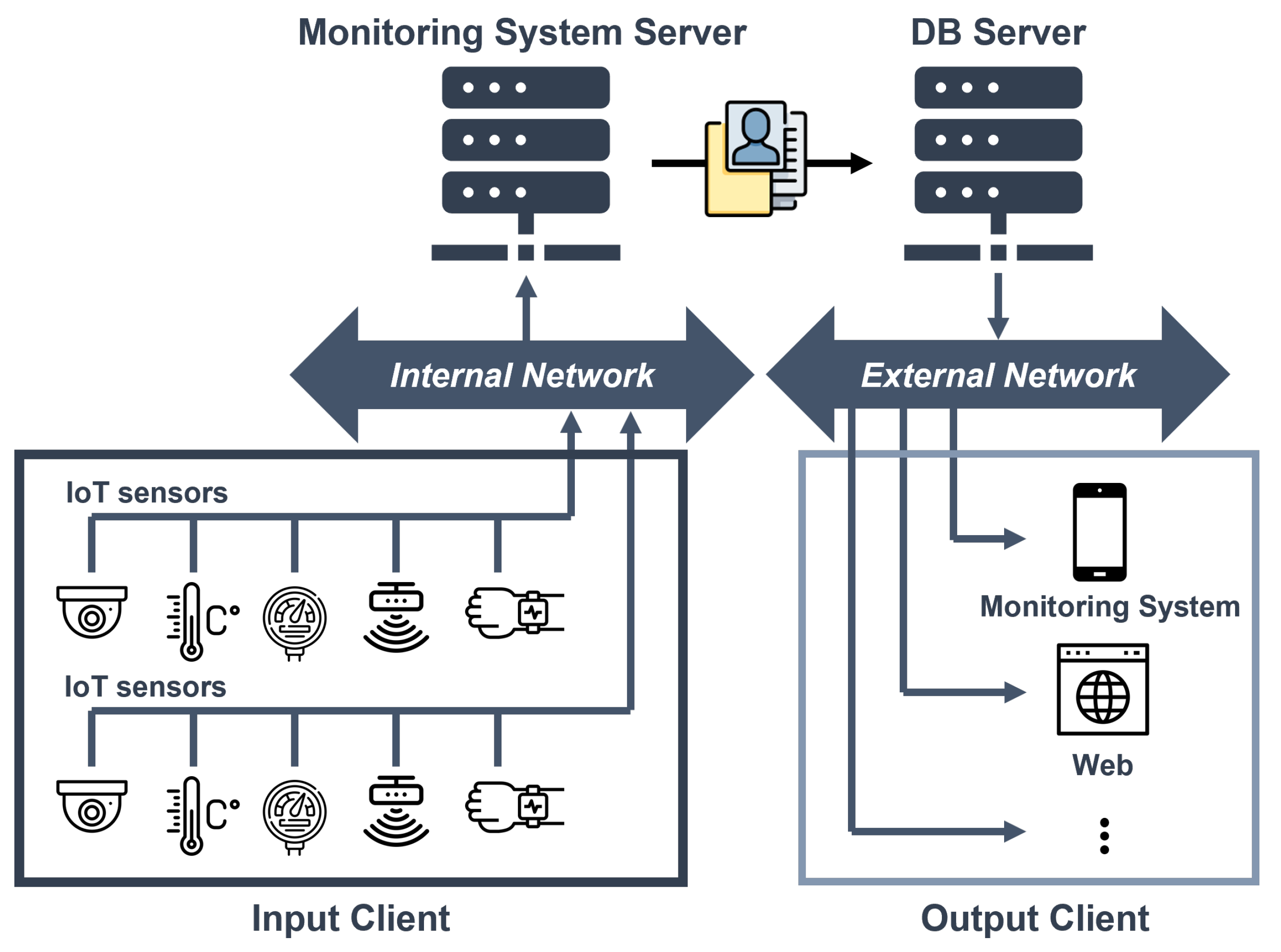
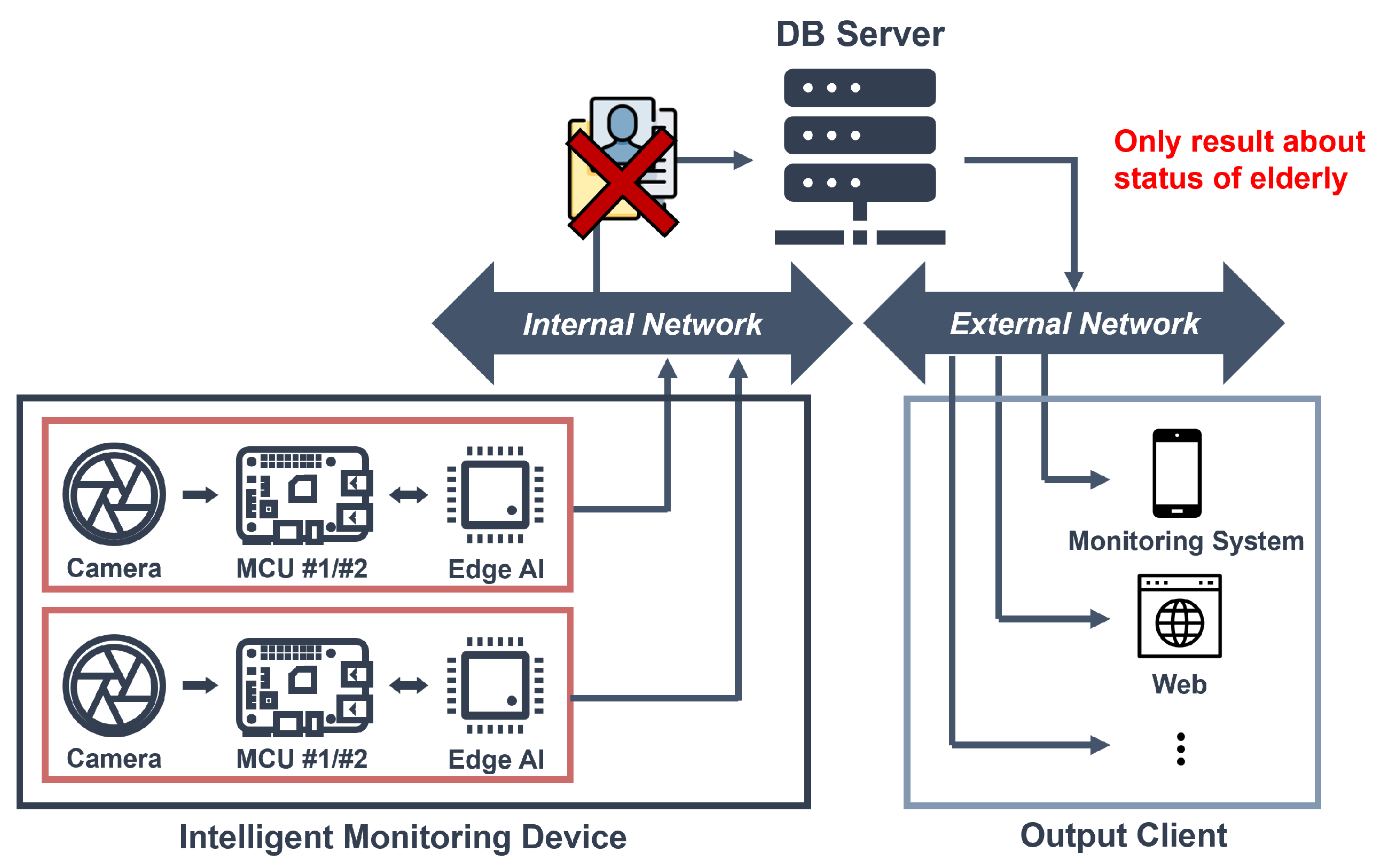

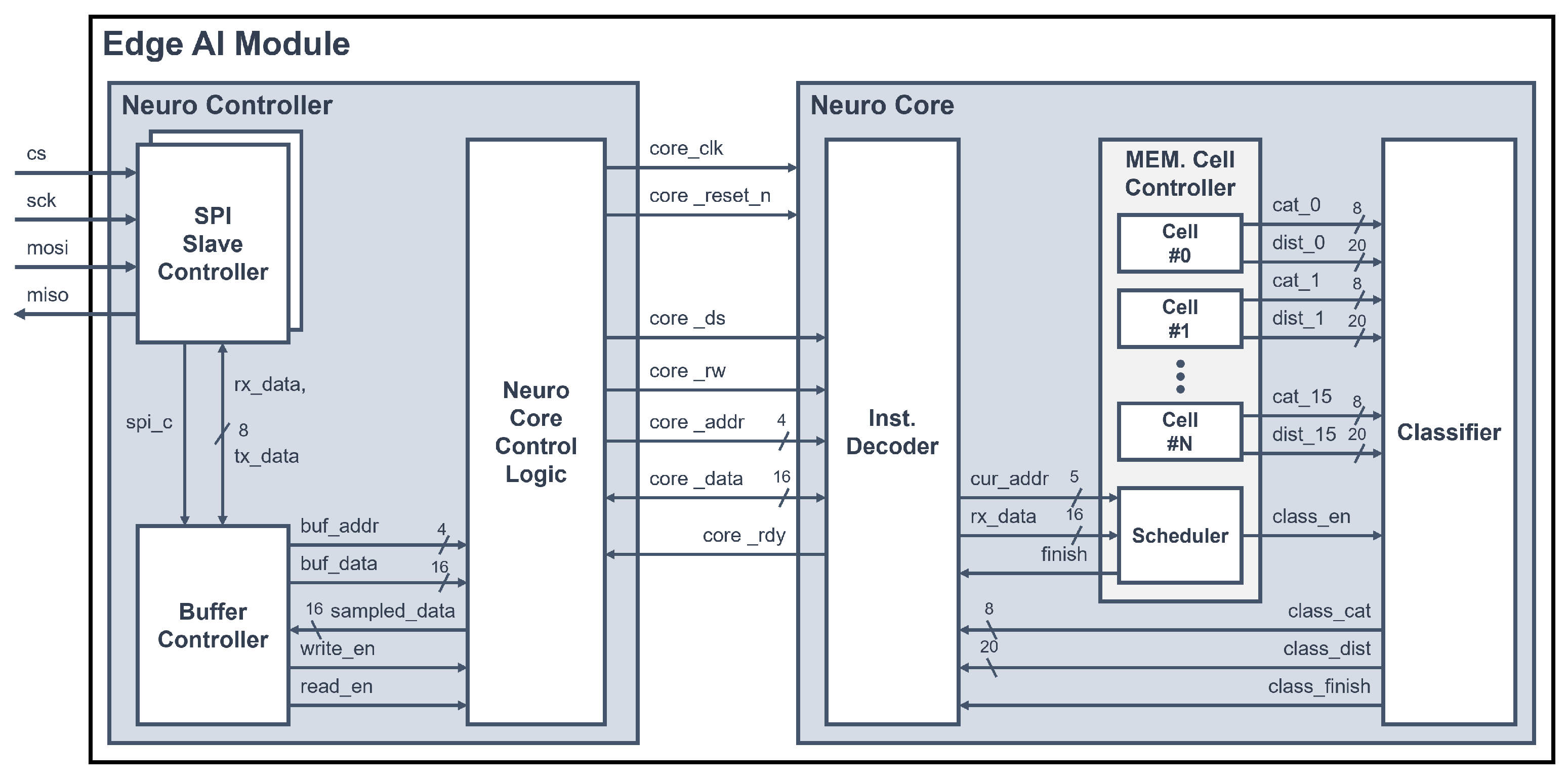

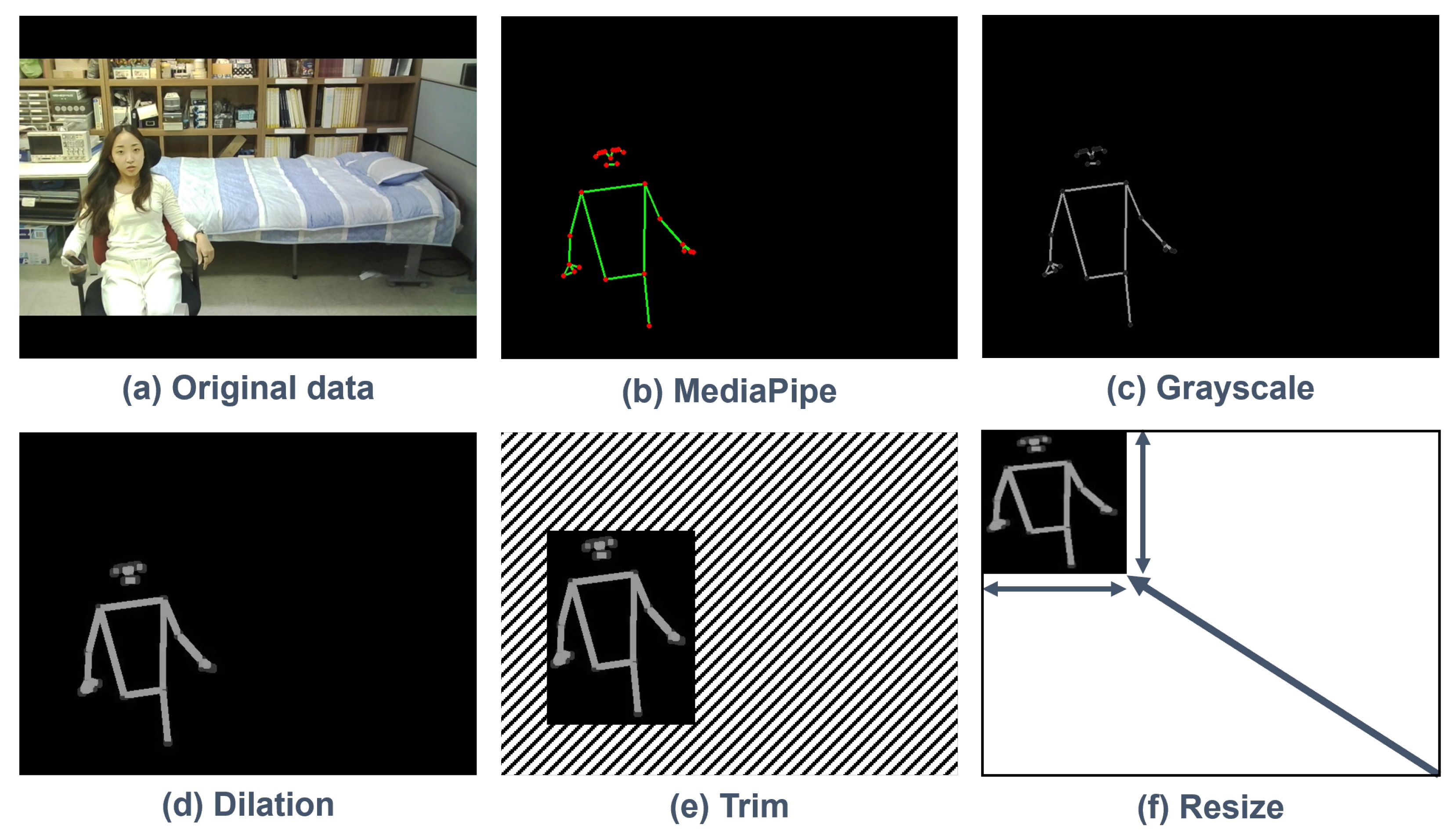

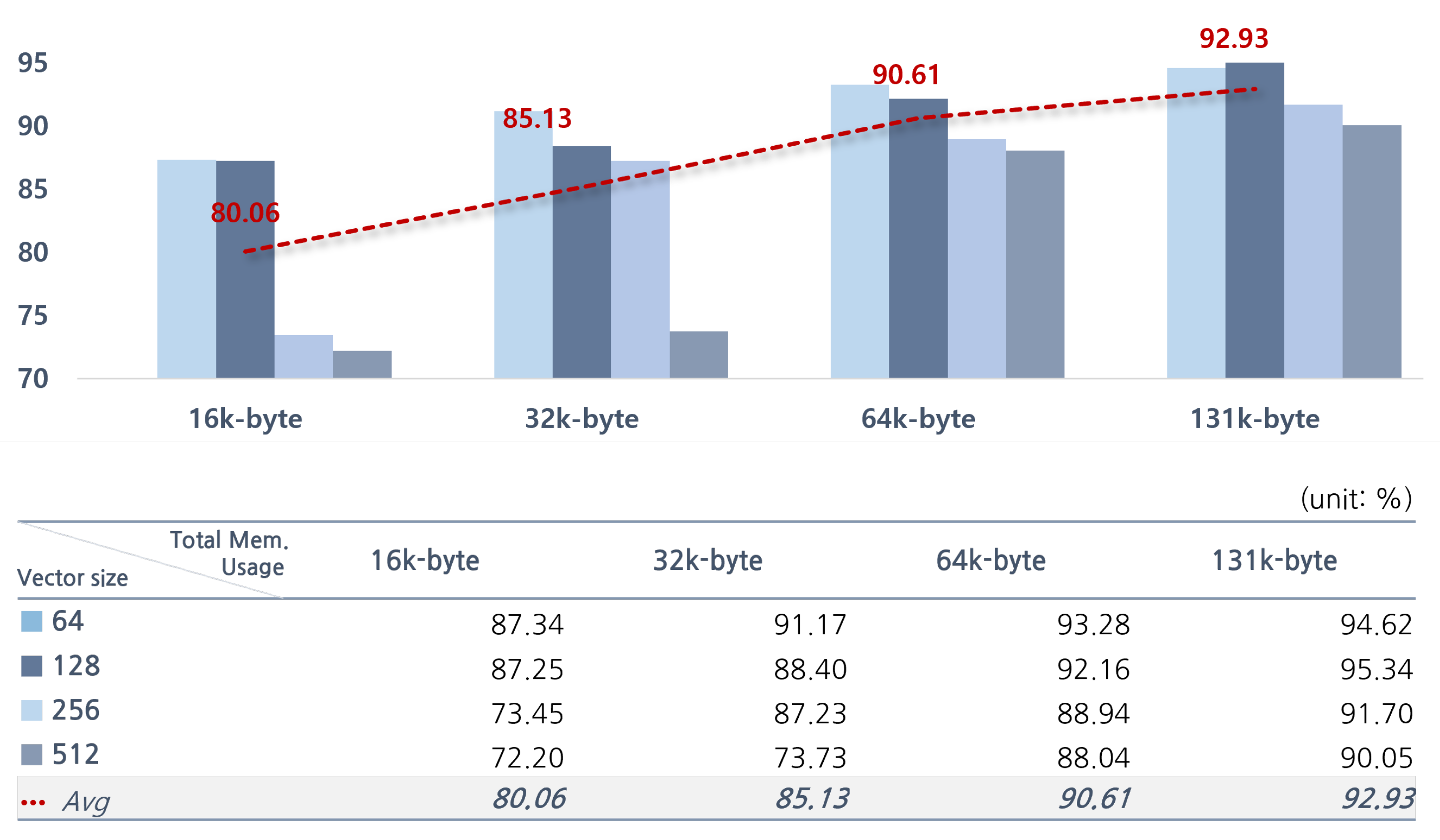
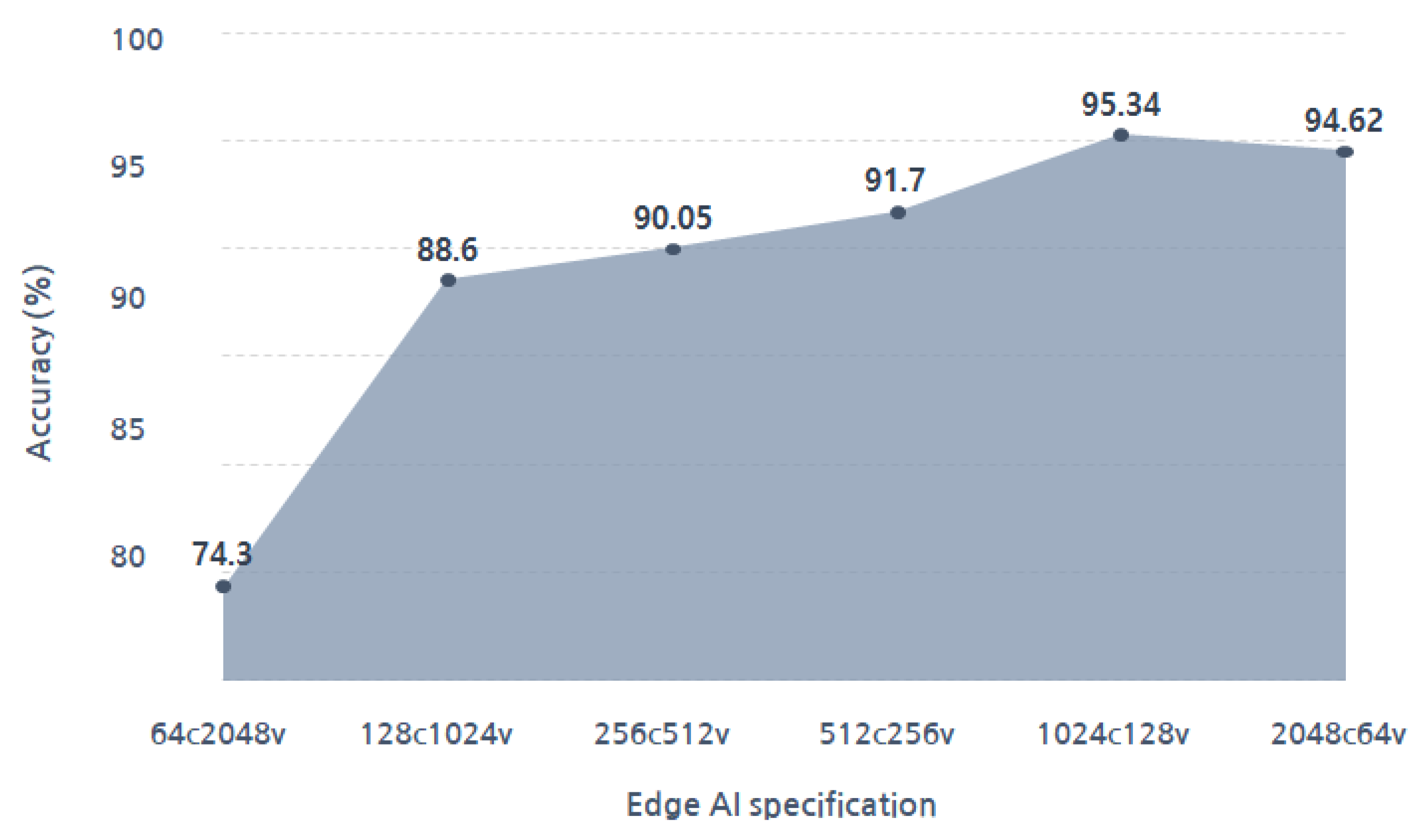
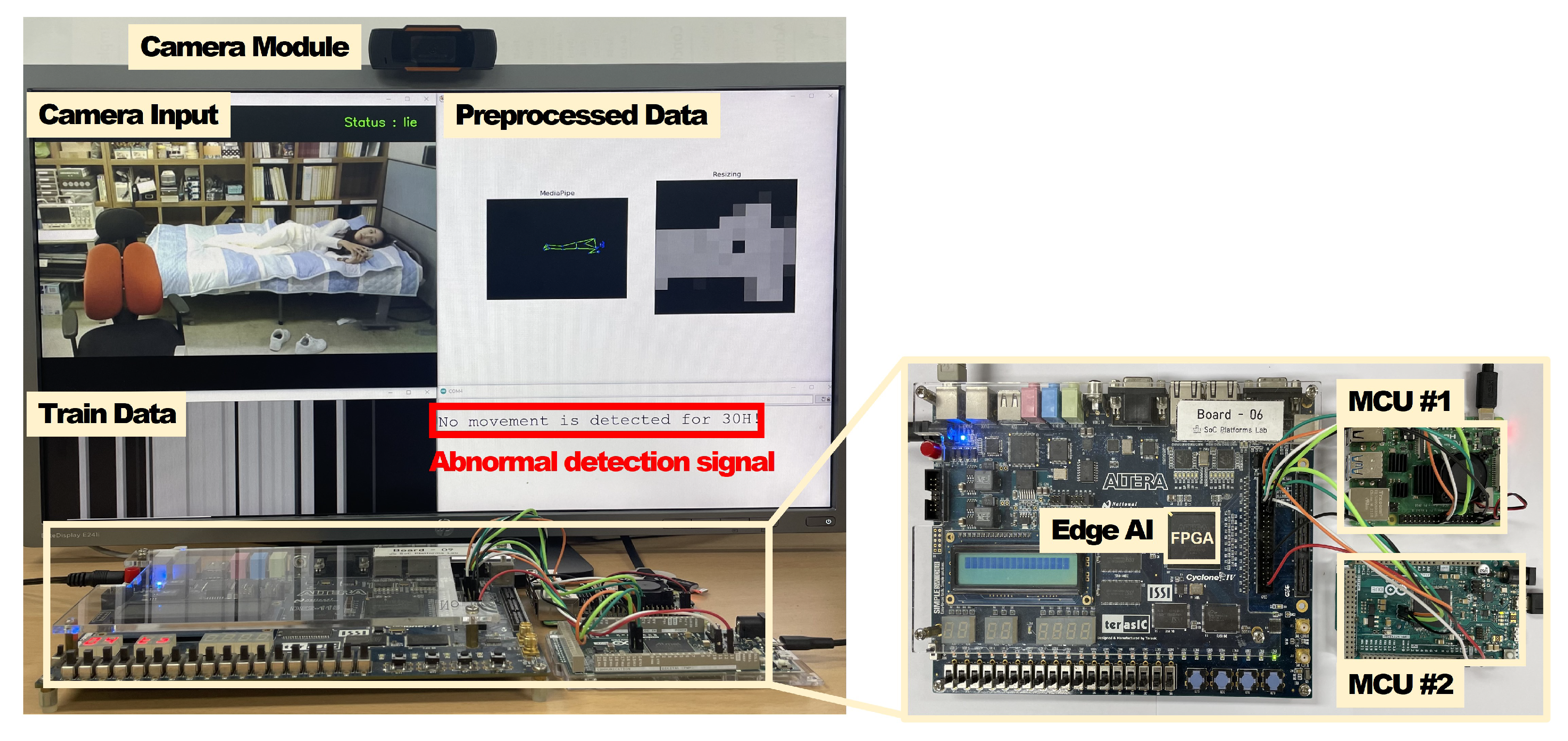
| Spec | Inst. Dec. | Mem. Cell Controller | Classifier | Neuro Core | Edge AI Module |
|---|---|---|---|---|---|
| 2048c64v | 322 | 1,162,841 | 1,778,715 | 2,941,878 | 2,943,295 |
| 1024c128v | 361 | 604,474 | 909,794 | 1,514,629 | 1,516,046 |
| 512c256v | 371 | 313,766 | 475,098 | 789,235 | 790,652 |
| 256c512v | 342 | 162,422 | 247,087 | 409,851 | 411,268 |
| 128c1024v | 371 | 83,936 | 128,168 | 212,475 | 213,893 |
| 64c2048v | 342 | 43,432 | 67,549 | 111,323 | 112,741 |
| Spec | Inst. Dec. | Mem. Cell Controller | Classifier | Neuro Core | Edge AI Module |
|---|---|---|---|---|---|
| 1024c128v | 0.0983 mW | 145.501 mW | 198.742 mW | 344.3413 mW | 344.44 mW |
Disclaimer/Publisher’s Note: The statements, opinions and data contained in all publications are solely those of the individual author(s) and contributor(s) and not of MDPI and/or the editor(s). MDPI and/or the editor(s) disclaim responsibility for any injury to people or property resulting from any ideas, methods, instructions or products referred to in the content. |
© 2023 by the authors. Licensee MDPI, Basel, Switzerland. This article is an open access article distributed under the terms and conditions of the Creative Commons Attribution (CC BY) license (https://creativecommons.org/licenses/by/4.0/).
Share and Cite
Kim, S.; Park, J.; Jeong, Y.; Lee, S.E. Intelligent Monitoring System with Privacy Preservation Based on Edge AI. Micromachines 2023, 14, 1749. https://doi.org/10.3390/mi14091749
Kim S, Park J, Jeong Y, Lee SE. Intelligent Monitoring System with Privacy Preservation Based on Edge AI. Micromachines. 2023; 14(9):1749. https://doi.org/10.3390/mi14091749
Chicago/Turabian StyleKim, Soohee, Joungmin Park, Youngwoo Jeong, and Seung Eun Lee. 2023. "Intelligent Monitoring System with Privacy Preservation Based on Edge AI" Micromachines 14, no. 9: 1749. https://doi.org/10.3390/mi14091749
APA StyleKim, S., Park, J., Jeong, Y., & Lee, S. E. (2023). Intelligent Monitoring System with Privacy Preservation Based on Edge AI. Micromachines, 14(9), 1749. https://doi.org/10.3390/mi14091749









